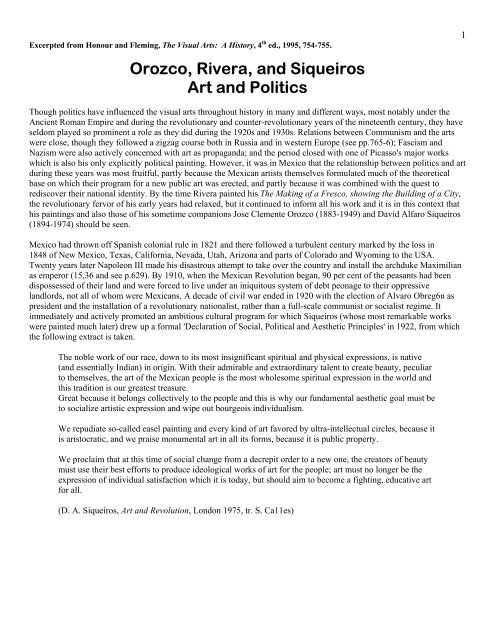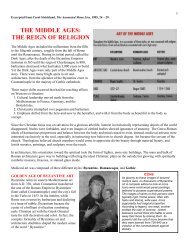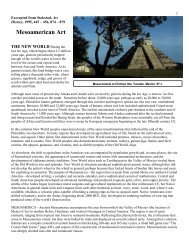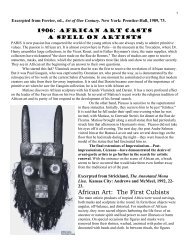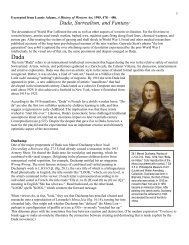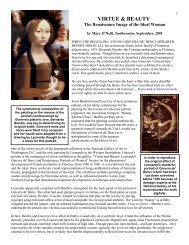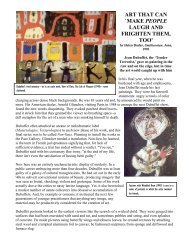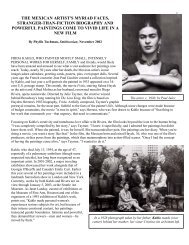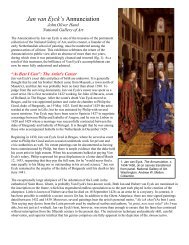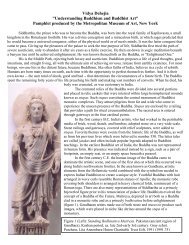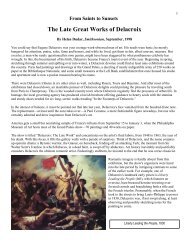Orozco, Rivera, and Siqueiros Art and Politics - Phs.poteau.k12.ok.us
Orozco, Rivera, and Siqueiros Art and Politics - Phs.poteau.k12.ok.us
Orozco, Rivera, and Siqueiros Art and Politics - Phs.poteau.k12.ok.us
- No tags were found...
You also want an ePaper? Increase the reach of your titles
YUMPU automatically turns print PDFs into web optimized ePapers that Google loves.
Excerpted from Honour <strong>and</strong> Fleming, The Visual <strong>Art</strong>s: A History, 4 th ed., 1995, 754-755.<strong>Orozco</strong>, <strong>Rivera</strong>, <strong>and</strong> <strong>Siqueiros</strong><strong>Art</strong> <strong>and</strong> <strong>Politics</strong>1Though politics have influenced the visual arts throughout history in many <strong>and</strong> different ways, most notably under theAncient Roman Empire <strong>and</strong> during the revolutionary <strong>and</strong> counter-revolutionary years of the nineteenth century, they haveseldom played so prominent a role as they did during the 1920s <strong>and</strong> 1930s. Relations between Communism <strong>and</strong> the artswere close, though they followed a zigzag course both in R<strong>us</strong>sia <strong>and</strong> in western Europe (see pp.765-6); Fascism <strong>and</strong>Nazism were also actively concerned with art as propag<strong>and</strong>a; <strong>and</strong> the period closed with one of Picasso's major workswhich is also his only explicitly political painting. However, it was in Mexico that the relationship between politics <strong>and</strong> artduring these years was most fruitful, partly beca<strong>us</strong>e the Mexican artists themselves formulated much of the theoreticalbase on which their program for a new public art was erected, <strong>and</strong> partly beca<strong>us</strong>e it was combined with the quest torediscover their national identity. By the time <strong>Rivera</strong> painted his The Making of a Fresco, showing the Building of a City,the revolutionary fervor of his early years had relaxed, but it continued to inform all his work <strong>and</strong> it is in this context thathis paintings <strong>and</strong> also those of his sometime companions Jose Clemente <strong>Orozco</strong> (1883-1949) <strong>and</strong> David Alfaro <strong>Siqueiros</strong>(1894-1974) should be seen.Mexico had thrown off Spanish colonial rule in 1821 <strong>and</strong> there followed a turbulent century marked by the loss in1848 of New Mexico, Texas, California, Nevada, Utah, Arizona <strong>and</strong> parts of Colorado <strong>and</strong> Wyoming to the USA.Twenty years later Napoleon III made his disastro<strong>us</strong> attempt to take over the country <strong>and</strong> install the archduke Maximilianas emperor (15,36 <strong>and</strong> see p.629). By 1910, when the Mexican Revolution began, 90 per cent of the peasants had beendispossessed of their l<strong>and</strong> <strong>and</strong> were forced to live under an iniquito<strong>us</strong> system of debt peonage to their oppressivel<strong>and</strong>lords, not all of whom were Mexicans. A decade of civil war ended in 1920 with the election of Alvaro Obreg6n aspresident <strong>and</strong> the installation of a revolutionary nationalist, rather than a full-scale communist or socialist regime. Itimmediately <strong>and</strong> actively promoted an ambitio<strong>us</strong> cultural program for which <strong>Siqueiros</strong> (whose most remarkable workswere painted much later) drew up a formal 'Declaration of Social, Political <strong>and</strong> Aesthetic Principles' in 1922, from whichthe following extract is taken.The noble work of our race, down to its most insignificant spiritual <strong>and</strong> physical expressions, is native(<strong>and</strong> essentially Indian) in origin. With their admirable <strong>and</strong> extraordinary talent to create beauty, peculiarto themselves, the art of the Mexican people is the most wholesome spiritual expression in the world <strong>and</strong>this tradition is our greatest treasure.Great beca<strong>us</strong>e it belongs collectively to the people <strong>and</strong> this is why our fundamental aesthetic goal m<strong>us</strong>t beto socialize artistic expression <strong>and</strong> wipe out bourgeois individualism.We repudiate so-called easel painting <strong>and</strong> every kind of art favored by ultra-intellectual circles, beca<strong>us</strong>e itis aristocratic, <strong>and</strong> we praise monumental art in all its forms, beca<strong>us</strong>e it is public property.We proclaim that at this time of social change from a decrepit order to a new one, the creators of beautym<strong>us</strong>t <strong>us</strong>e their best efforts to produce ideological works of art for the people; art m<strong>us</strong>t no longer be theexpression of individual satisfaction which it is today, but should aim to become a fighting, educative artfor all.(D. A. <strong>Siqueiros</strong>, <strong>Art</strong> <strong>and</strong> Revolution, London 1975, tr. S. Ca11es)
2Before <strong>Rivera</strong> had completed his first great cycle of murals for the Ministry of Public Education, he painted another <strong>and</strong>only slightly less ambitio<strong>us</strong> series for the National Agricultural School at Chapingo j<strong>us</strong>t outside Mexico City. Agrarian<strong>and</strong> l<strong>and</strong> reform issues had been central to the Mexican Revolution ever since 1910 <strong>and</strong> in devoting this entire cycle tothem <strong>Rivera</strong> was able to realize more completely than in any other work his two great didactic themes, that of the social<strong>and</strong> political revolution <strong>and</strong> that of Mexico's national identity. Mexican Indians <strong>and</strong> peasants had begun to figureincreasingly in his murals as personifications of Mexico <strong>and</strong> at Chapingo they naturally took a central role together withthe l<strong>and</strong> itself, to which the whole cycle was conceived as a hymn based on Emiliano Zapata's words, 'here it is taught toexploit the l<strong>and</strong> not the man'. There are panels devoted to The Partition of the L<strong>and</strong> <strong>and</strong> to Good <strong>and</strong> Bad Government, thelatter recalling, if only in name, the frescoes by Lorenzetti at Siena. In the former chapel of the Agrarian School buildingstwo carefully balanced series depict in complementary manner the revolutionary transfer of the ownership of the l<strong>and</strong> <strong>and</strong>the biological <strong>and</strong> geological evolution of the earth, th<strong>us</strong> conveying <strong>Rivera</strong>'s vision of the one as a counterpart of theother. The whole theme is summarized in two panels on either side of the chapel entrance, one depicting The Agitator(20,13), the other The Blood of the Revolutionary Martyrs Fertilizing the Earth.20.13 Diego <strong>Rivera</strong>. The Agitator, 1926. Fresco. 8 ft x 18 ft 2'. Autonomo<strong>us</strong> University of Chapingo. Mexico.In contrast to <strong>Rivera</strong>'s work in the USA, that of <strong>Orozco</strong> became more rather than less outspoken, notably in the murals hepainted for the Baker Library of Dartmouth College in Hanover, Massach<strong>us</strong>etts, in 1932. <strong>Orozco</strong> was in no way inhibitedby the fact that Dartmouth College had become aprestigio<strong>us</strong> East Coast bastion of white Anglo-Saxonprivilege despite having been founded specifically toprovide education for North American Indians. Indeedthe College's equivocal past set the theme: that of acontinent characterized by the dualities of its conflictingIndian <strong>and</strong> European historical experiences. <strong>Orozco</strong>'sconception of the American 'idea' centered on the mythof Quetzacoatl <strong>and</strong> was represented on the two mainwalls of the library with murals of America's Pre-Columbian civilization confronting post-CortesAmerica. The final panels in the series show, firstly, achilly world of puritan conformity with white schoolchildrenst<strong>and</strong>ing obediently around their straight-lacedwoman teacher. In contrast, Hispanic or Latin Americais represented by a tragic but also potentially heroicworld in which the rebel Emiliano Zapata st<strong>and</strong>s as theonly upright figure among corrupt politicians <strong>and</strong>generals (20,14). <strong>Orozco</strong> said apropos this powerfulimage that the best representation of Hispanic-American20.14 Jose Clemente <strong>Orozco</strong>, American Civilization—Latin America,detail of post-Cortesian section, 1932. Fresco, about 9 ft lO ins x 9 ft lOins. Commissioned by the Tr<strong>us</strong>tees of the Dartmouth College, Hanover,New Hampshire.
3idealism, not as an abstract idea but as an accomplished fact, would be, I think, the figure of a rebel. After the destructionof the armed revolution (whether against a foreign aggressor or local exploiter or dictator! there remains a triumphantideal with the chance of realization. If there is any need for expressing in j<strong>us</strong>t one sentence the highest ideal of theHispanic-American here, it would be as follows: “J<strong>us</strong>tice whatever the cost".' Zapata is being stabbed in the back by aNorth American general in <strong>Orozco</strong>'s mural <strong>and</strong>, significantly, the general is accompanied by some of Zapata's owncountrymen as well as by foreign b<strong>us</strong>inessmen. In the final panel <strong>Orozco</strong> delivered his deeply pessimistic judgment onmodern America. Echoing Quetzacoatl’s condemnation of his people's worship of false gods, he castigated hiscontemporaries' false knowledge <strong>and</strong> their worship of money <strong>and</strong> power <strong>and</strong> the violence of their blind nationalism. As afinal gesture of despair he painted in the background a junk heap, the detrit<strong>us</strong> of an ind<strong>us</strong>trial <strong>and</strong> consumer society.88888888888888888888Excerpted from Kathleen Krull, Lives of the <strong>Art</strong>ists,1995, 85 – 89.FROG-FACE AND THE WALKINGFLOWERDIEGO RIVERA& FRIDA KAHLOBORN IN 1886 IN GUANAJUATO, MEXICO, ANDDIED IN 1957 IN MEXICO CITY, MEXICO(RIVERA)BORN IN 1907 AND DIED IN 1954 INCOYOACAN, MEXICO (KAHLO)Distinguished Mexican muralist <strong>and</strong> distinctiveMexican painterStormily married to each otherWHEN DIEGO RIVERA <strong>and</strong> Frida Kahlo weremarried, he was forty-two <strong>and</strong> on his third marriage;she was twenty-two <strong>and</strong> the marriage was her first. Hewas a national monument; she was teaching herself topaint. And there were plenty of other differencesbetween them.People called them the Elephant <strong>and</strong> the Dove.He weighed three hundred pounds <strong>and</strong> was more thansix feet tall, so large that he couldn't find underwear tofit (she had it made for him, in bright pink cotton). Shewas ninety-eight pounds <strong>and</strong> five feet three inches.<strong>Rivera</strong> was someone to lean on, with the energy of ten men, capable of working for days at a time. Kahlo was fragile.Childhood polio had ca<strong>us</strong>ed one of her legs to stop growing, <strong>and</strong> at age eighteen she suffered severe injuries when she waspierced by an iron h<strong>and</strong>rail in a horrific b<strong>us</strong> accident. She went on to endure thirty-two operations in attempts to relievethe pain. She couldn't paint for more than an hour at a time <strong>and</strong> was often bedridden.<strong>Rivera</strong>'s art covered entire buildings <strong>and</strong> dealt encyclopedically with the l<strong>and</strong> <strong>and</strong> people of Mexico. Kahlo's paintingswere small—some the size of this book –<strong>and</strong> most were deeply personal.<strong>Rivera</strong> was a messy dresser. He wore baggy overalls (<strong>us</strong>ually paint-smeared), big black shoes, a Stetson hat, <strong>and</strong> he oftencarried a large pistol. Kahlo took such exquisite care with her clothes, no matter how she was feeling, that people calledher the Walking Flower. She wore elaborate blo<strong>us</strong>es, long skirts of purple or red velvet, <strong>and</strong> layers of petticoats sheembroidered with Mexican sayings. She pulled her hair back tightly, embellishing it with clips, combs, <strong>and</strong> fresh
lossoms. Sometimes she wore so much jewelry—she was known to wear twenty rings at once—that she clanked whenshe moved.4He ate a lot (Kahlo would bring him big lunches in baskets covered with flowers <strong>and</strong> love notes), while she was a pickyeater. She could think of only three American foods she liked: malted milk, applesauce, <strong>and</strong> American cheese.<strong>Rivera</strong> could be genero<strong>us</strong> but frequently was unreliable, too absorbed in his work to take much interest in people ormoney—sometimes he left large checks lying around for years before he cashed them. Kahlo was thoughtful <strong>and</strong> couldlisten to people for hours, always wanting to hear someone's life story. She kept scrupulo<strong>us</strong> accounts of her money.At fifteen Kahlo had told friends that her ambition was to have children with the famo<strong>us</strong> Diego <strong>Rivera</strong>. By the time theymarried, he didn't want more than the several children he already had, <strong>and</strong> after numero<strong>us</strong> miscarriages, Kahlo sadlyaccepted that she was too frail to have children.For all their differences, what kept Kahlo <strong>and</strong> <strong>Rivera</strong> together?Both loved to laugh. She had a contagio<strong>us</strong> belly laugh <strong>and</strong> once wrote, "Nothing is worth more than laughter. " She triedwhenever possible to deal with her pain by <strong>us</strong>ing humor. <strong>Rivera</strong> was known as a hugely entertaining teller of tall tales <strong>and</strong>made-up stories about himself. At parties the two of them made friends laugh by pouring powdered sugar allover a table<strong>and</strong> creating cityscapes.Both were concerned about improving theircountry's government. <strong>Rivera</strong> believed thatart could transform society <strong>and</strong> that muralswere the best way for ordinary people to seeart. Kahlo joined him in marches <strong>and</strong> otherefforts for social change.They both had strong opinions—<strong>and</strong> so hadmany fights, separations, <strong>and</strong>reconciliations. Each also had many affairs,but they always came back to one another—each was the central figure in the other's life.When Kahlo was in the hospital, <strong>Rivera</strong>would rock her to sleep or entertain her bypretending to be a circ<strong>us</strong> bear dancingaround her bed with a tambourine. Shesigned her letters to him with magenta-pinklipstick kisses <strong>and</strong> did everything she couldto make him happy.Both drew crowds. <strong>Rivera</strong> at work was considered a m<strong>us</strong>t-see tourist attraction; people would buy tickets j<strong>us</strong>t to watchhim paint. Kahlo <strong>and</strong> her outfits could stop traffic; parades of children would follow her. Together they were asensation—he presented himself like a king; she carried herself like a queen. When they entered a theater, people lookedat them instead of at the performers on stage. Details of their colorful, glamoro<strong>us</strong> life were written up in the papers, <strong>and</strong>people the world over addressed them by their first names.Both were childlike <strong>and</strong> easily bored with anything except themselves <strong>and</strong> each other. He preferred her to bathe him(otherwise he wouldn't bathe) <strong>and</strong> dem<strong>and</strong>ed lots of bath toys. She had an enormo<strong>us</strong> collection of dolls (whenever friendsleft on a trip, she would request, "Bring me a doll") <strong>and</strong> pets, including spider monkeys, turkeys, <strong>and</strong> parrots. One parrotnamed Bonito slept under the covers with her.They liked each other's looks. <strong>Rivera</strong> admired Kahlo's eyebrows, which met in the middle, <strong>and</strong> her m<strong>us</strong>tache -he wasfurio<strong>us</strong> once when she shaved it off. During especially bitter quarrels, she would wound him by cutting off her long hair.She teasingly called him Frog-Face <strong>and</strong> Fatbelly, but in truth she adored his Buddha, like appearance. .
5Above all they respected each other's art. Kahlo thought <strong>Rivera</strong> was the greatest artist in the world <strong>and</strong> defended himverbally <strong>and</strong> even physically—she once jumped between him <strong>and</strong> a man with a gun. When Picasso asserted that no onecould paint like Kahlo, <strong>Rivera</strong> agreed. "We are all clods next to Frida," <strong>Rivera</strong> said, <strong>and</strong> he did all he could to encourageher. Both were successful. Critics lionized him, <strong>and</strong> she had no trouble selling every work she painted.They lived in Mexico City in two separate ho<strong>us</strong>es linked by a bridge. Her ho<strong>us</strong>e was blue; his ho<strong>us</strong>e was pink. Concernedover neighbors' approval of their guests, they simply bought the lot next door to put more distance between themselves<strong>and</strong> their neighbors. After a long breakfast together, he would disappear to work <strong>and</strong> she would go to her studio, to Tarzanmovies (or the Three Stooges or the Marx Brothers) or to boxing matches. At night they met for late suppers of hotchocolate <strong>and</strong> sweet rolls.Less than a year before she died at age forty-seven, Kahlo made herself part of an exhibit of her work. Too ill to leave herhuge four-poster bed, she had the bed moved to the gallery, where friends sang songs to her. The last words she wrote inher diary were: "I hope the exit is joyful- <strong>and</strong> I hope never to come back." After her death friends reported that <strong>Rivera</strong>became "an old man in a few hours." He soon remarried but died at age seventy-one, within three years of his marriage,after a stroke.WORKS<strong>Rivera</strong> painted more than two <strong>and</strong> a half miles of murals in his lifetime. The first was a series of 124 panels encompassingthe entire history of Mexico. It took him more than four years, working eight to fifteen hours at a stretch, to do all thepainting by h<strong>and</strong>. Upon completing the work he was instantly famo<strong>us</strong>.<strong>Rivera</strong>'s murals—which always sparked controversy—were vulnerable toattack by mutilation or acid throwing. The most vigoro<strong>us</strong> protest camewhen <strong>Rivera</strong> (a "foreigner") worked inside New York City's Radio CityM<strong>us</strong>ic Hall; his murals were destroyed before he could finish.The Two Fridas, probably Kahlo's most famo<strong>us</strong> work, was painted duringa painful separation from <strong>Rivera</strong>; they divorced <strong>and</strong> remarried the nextyear. Most of her work was autobiographical; when she was bedridden itwas convenient, with mirror in h<strong>and</strong>, to paint herself. Those who didn'tfind her work shockingly personal valued it highly. Diego <strong>and</strong> I becamethe first Latin American painting to sell for more than one million dollars;rock star Madonna owns Self-Portrait with Monkey <strong>and</strong> other Kahlo works.In Frida <strong>and</strong> Diego <strong>Rivera</strong> (right), the painting Kahlo did for theirwedding, he holds his palette <strong>and</strong> br<strong>us</strong>hes more tightly than he holds herh<strong>and</strong>, her way of showing that with him art came first. She holds no artsupplies, to show that she valued him even more than her art.


